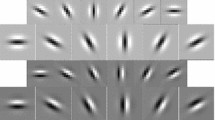Abstract
In this work we describe the implementation of an artificial neural network, an extension of Hopfield's model, for the supervised segmentation of textured images. We use a Markov random field in order to model the textures in the image. The problem is approached in terms of the minimization of a objective function which integrates statistical and spatial information and which is projected onto the network. It provides a locally optimal solution to the problem of the classification of M*M pixels into K classes (textures). The experimental results obtained on artificial and natural images show the validity of the architecture we propose.
Preview
Unable to display preview. Download preview PDF.
Similar content being viewed by others
References
P. Brodatz. “Textures: A photographic album for artistis & designers”. Dover Publications, New York, 1966.
R. Chellappa. “Two-dimensional discrete Gaussian Markov random field models for image processing”, in Progress in Pattern Recognition 2 (L.N Kanal and A. Rosenfeld, Eds.), pp. 79–112, Elsevier, New York, 1985.
R. Chellappa and S. Chatterjee. Classification of textures using Gaussian Markov Random fields. IEEE Trans. Acoustic, Speech and Signal Processing, vol. ASSP-33, n. 4, pp. 959–963. 1985.
S.F. Cohen and D.V, Cooper. “Simple Parallel Hierarchical and Relaxation Algorithms for Segmenting Noncausal Markovian Random Fields”. IEEE Trans. Pattern Anal. Machine Intell., vol. PAMI-9, pp. 195–219, 1987.
G.R. Cross and A.K. Jain. “Markov random field texture models”. IEEE Trans. Pattern. Anal. Machine Intell., vol. PAMI-5, pp. 25–39, 1983.
M. Hassner and J. Sklansky. “The use of Markov random fields as model of texture”. Comput. Graphics Image Processing, vol. 12, pp. 357–370, 1980.
Chung-Lin Huang. “Parallel image segmentation using modofied Hopfield model”. Pattern Recognition Letters vol. 13, pp. 345–353, 1992.
J.J. Hopfield and D. W. Tank. “Computing with Neural Circuits: A model”. Science, vol. 233, pp. 625–633, 1986.
R.L. Kashyap and R. Chellappa. “Estimation and Choice of Neighbors in Spatial-Interaction Model of Images”. IEEE Trans. Information Theory, vol. IT-29, pp. 60–72, 1983.
R.L. Kashyap and A. Khotanzad. A sthocastic model based technique for texture segmentation. Seventh International Conference on Pattern Recognition, Montreal, 1984, pp. 1202–1205.
B.S. Manjunath, Tal Simchony and R. Chellappa. “Stochastic and deterministic networks for texture segmentation”. IEEE Trans. Acoust., Speech, Signal Process. vol. 38, pp. 1039–1049, 1990.
A. Mosquera, D. Cabello, M.J. Carreira and M.G. Penedo. “Unsupervised textured image segmentation using Markov random field and clustering algorithms”. In Computer Analysis of Images and Patterns (R. Klette, Ed.). Research in Informatics, vol. 5, pp. 139–147, Akademie Verlag, Berlin, 1991.
A. Mosquera, D. Cabello, J.M. Mallo, M.J. Carreira and M.G. Penedo. “Functional Neighborhood in Markov Random Fields: Generalized Texture Models”. The 8th Sacandinavian Conference on Image Analysis. Tromsø, Norway, may, 1993.
A.L. Vickers and J.W. Modestino. A maximum likelihood approach to texture classification. IEEE Trans. Pattern Anal. Machine Intell. vol. PAMI-4, n.1, pp. 61–68, 1982.
J.W. Woods. Two-dimensional discrete Markivian Fields. IEEE Trans. Information Theory, vol. IT-18, n.2, pp. 232–240, 1972.
Author information
Authors and Affiliations
Editor information
Rights and permissions
Copyright information
© 1993 Springer-Verlag Berlin Heidelberg
About this paper
Cite this paper
Mosquera, A., Cabello, D., Carreira, M.J., Penedo, M.G. (1993). Texture image segmentation using a modified Hopfield network. In: Mira, J., Cabestany, J., Prieto, A. (eds) New Trends in Neural Computation. IWANN 1993. Lecture Notes in Computer Science, vol 686. Springer, Berlin, Heidelberg. https://doi.org/10.1007/3-540-56798-4_217
Download citation
DOI: https://doi.org/10.1007/3-540-56798-4_217
Published:
Publisher Name: Springer, Berlin, Heidelberg
Print ISBN: 978-3-540-56798-1
Online ISBN: 978-3-540-47741-9
eBook Packages: Springer Book Archive




